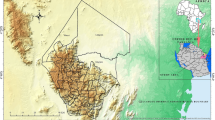Abstract
An evaluation model divided landslide hazard degrees in Wanzhou District of Three Gorges Reservoir Area. The model was established by GIS techniques and took land use/cover, stratum characters, slope aspect, slope gradient, elevation difference and slope shape as evaluation factors. The data of land use/cover were obtained by remote sensing, and the weights of the factors mentioned above were established by the analytic hierarchy process (AHP). The results indicate, low danger areas in the studied area account for 66.51%, and high danger areas and very high danger areas occupy 1/3 of the total area. The regions of high and very high danger are mainly located around the urban area of Wanzhou District and on the banks of the Yangtze River with a relatively large area, where collapse and landslide directly threats densely populated areas and Three Gorges Reservoir. Slope destabilization, if occurs, will bring huge loss to social economy. All research results are consistent with the actual conditions; therefore, they can be regarded as a useful basis for planning and constructing of the reservoir area.
Similar content being viewed by others
References
Chang Zhounghua, Wu Faquan, Zhang Eryon,et al. Deformation and Failure Modes and Genetic Mechanisms of Typical Rocky Slopes in Fengjie County, Three Gorges Reservoir Region [J].The Chinese Journal of Geological Hazard and Control, 2004,15(4): 20–24 (Ch).
Wang Chenghua, Chen Yongbo. Mechanism and Cause of Disaster of Wulong Landslide[J].Journal of Natural Disasters, 2002,11(1): 108–112 (Ch).
Shen Liangfeng, Liao Jiyuan, Zhang Yuelong. Summary on the Evaluation Methods of Slope Stability [J].Mining Research and Development, 2005,25(1): 24–27.
Cai F, Ugai K, Wakai A. Effects of Horizontal Drains on Slope Stability under Rainfall by Three-Dimensional Finite Element Analysis [J].Computers and Geotechnics,23 (1998): 255–275.
Mello U, Pratson L. Regional Slope Stability and Slope-Failure Mechanics from the Two-Dimensional State of Stress in an Infinite Slope [J].Marine Geology, 1999,154: 339–356.
Qiao Jianping, Wu Caiyan, Tian Hongling. Contribution Rate Research of Stratum to Landslide Growth of Yunyang-Wushan Segment in Three Gorges Reservoir Region [J].Chinese Journal of Rock Mechanics and Engineering, 2004,23(17): 2920–2924 (Ch).
WU Caiyan, QIAO Jianping. The Contributing Rate Research of Slope Aspect to Landslide Growth from Yunyang to Wushan in Three Gorges Reservoir Region [J].Journal of Sichuan University (Engineering Science Edition), 2005,37(4): 25–29 (Ch).
Kentli B, Topal T. Assessment of Rock Slope Stability for a Segment of the Ankara-Pozanti Motorway, Turkey [J].Engineering Geology, 2004,74: 73–90.
Wang Chenghua, Kong Jiming. The Differentiating Danger Slope Occurring High-Speed Landslide [J].Journal of Engineering Geology, 2001,9(2): 127–132 (Ch).
Fan Xiaoyi, Qiao Jianping. Topography Discriminance of the Assessment Landslide Hazard Degree[J].Journal of mountain science, 2004,22(6): 730–734 (Ch).
He Yiping, Ma Zezhong, Xie Hong,et al. Mountain Hazard Intergraded Sensitivity on Land Use of the Upper Reaches of Yangtz River—A Case Study of Xiaojiang River Basin [J].Resources and Environment in the Yangtze Basin, 2005,14 (4): 528–533 (Ch).
Zhong Cheng, He Zongyi, Liu Shu-zheng. Evalution of Eco-Environmental Stability Based on GIS in Tibet, China[J].Wuhan University Journal of Natural Science, 2005,10 (4): 653–658.
Qiao Jianping, Zhao Yu, Yang Wen. Study on Landslide Danger Degree Division in the Area of Sichuan Province and Chongqing City [J].Journal of Natural Disasters, 2000,9 (1): 68–71 (Ch).
Ercanoglu M, Gokceogl C. Use of Fuzzy Relations to Produce Landslide Susceptibility Map of a Landslide Prone Area (West Black Sea Region, Turkey) [J].Environmental Geology, 2004,75: 229–250.
Author information
Authors and Affiliations
Corresponding author
Additional information
Foundation item: Supported by the Knowledge Innovation Project of Chinese Academy of Science (KZCX2-SW-319-01)
Biography: ZHOU Qigang (1976-), male, Ph. D. candidate, research direction: application and research of remote sensing and GIS.
Rights and permissions
About this article
Cite this article
Qigang, Z., Wenlan, F., Shujun, S. et al. Remote sense and GIS-based division of landslide hazard degree in Wanzhou district of the Three Gorges Reservoir Area. Wuhan Univ. J. Nat. Sci. 11, 780–786 (2006). https://doi.org/10.1007/BF02830164
Received:
Issue Date:
DOI: https://doi.org/10.1007/BF02830164




